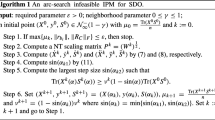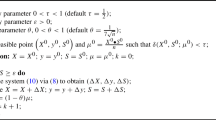Abstract
We propose a wide neighborhood primal-dual interior-point algorithm with arc-search for semidefinite programming. In every iteration, the algorithm constructs an ellipse and searches an \(\varepsilon \)-approximate solution of the problem along the ellipsoidal approximation of the central path. Assuming a strictly feasible starting point is available, we show that the algorithm has the iteration complexity bound \(O\left( n^{\frac{3}{4}}\log \frac{{X^{0}}\bullet {S}^{0}}{\varepsilon }\right) \) for the Nesterov–Todd direction, which is similar to that of the corresponding algorithm for linear programming. The numerical results show that our algorithm is efficient and promising.
Similar content being viewed by others
References
Alizadeh, F.: Combinatorial optimization with interior-point methods and semi-definite matrices. Ph.D. thesis, Computer Science Department, University of Minnesota, Minneapolis, MN (1991)
Boyd, S., El Ghaoui, L., Feron, E., Balakrishnan, V.: Linear Matrix Inequalities in System and Control Theory. SIAM, Philadelphia (1994)
Overton, M.: Large-scale optimization of eigenvalues. SIAM J. Optim. 2, 88–120 (1992)
Kojima, M., Shindoh, S., Hara, S.: Interior-point methods for the monotone semidefinite linear complementarity problem in symmetric matrices. SIAM J. Optim. 7, 86–125 (1997)
Nesterov, Y., Todd, M.: Primal-dual interior-point methods for self-scaled cones. SIAM J. Optim. 8, 256–268 (1998)
Vandenberghe, L., Boyd, S.: A primal-dual potential reduction method for problems involving matrix inequalities. Math. Program. 69, 205–236 (1995)
Hung, P., Ye, Y.: An asymptotocal \(O(\sqrt{n}L)\)-iteration path-following linear programming algorithm that use wide neighborhoods. SIAM J. Optim. 6, 570–586 (1996)
Jansen, B., Roos, C., Terlaky, T.: Improved complexity using higher-order correctors for primal-dual Dikin affine scaling. Math. Program. 76, 117–130 (1996)
Yang, Y.: Arc-search path-following interior-point algorithms for linear programming. Optimization Oline (2009). http://www.optimization-online.org/ARCHIVE_CAT/LINSDP/2009.html
Yang, Y.: A polynomial arc-search interior-point algorithms for linear programming. J. Optim. Theory. Appl. 158, 859–873 (2013)
Yang, Y.: CurveLP-A MATLAB implementation of an infeasible interior-point algorithm for linear programming. Numer. Algorithms 74, 967–996 (2017)
Yang, Y.: A polynomial arc-search interior-point algorithms for convex quadratic programming. Eur. J. Oper. Res. 215, 25–38 (2011)
Monteiro, R., Adler, I.: A polynominal-time primal-dual affine scaling algorithm for linear and convex quadratic programming and its power series extension. Math. Oper. Res. 15, 191–214 (1990)
Yang, X.M., Zhang, Y.K., Liu, H.M.: A wide neighborhood infeasible-interior-point method with arc-search for linear programming. J. Comput. Math. Appl. 51, 209–225 (2016)
Yang, X.M., Liu, H.W., Zhang, Y.K.: An arc-search infeasible-interior-point method for symmetric optimization in a wide neighborhood of the central path. Optim. Lett. 11, 135–152 (2017)
Yang, Y.G., Yamashita, M.: An arc-search \(O(nL)\) infeasible-interior-point algorithm for linear programming. Optim. Lett. 12, 781–798 (2018)
Pirhaji, M., Zangiabadi, M., Mansouri, H.: An \(l_2\)-neighborhood infeasible interior-point algorithm for linear complementarity problems. 4OR-Q. J. Oper. Res. 15, 111–131 (2017)
Kheirfam, B.: An arc-search interior point method in the \(N_{\infty }^{-}(\gamma )\) neighborhood for symmetric optimization. Fund. Inform. 146, 255–269 (2016)
Kheirfam, B.: An arc-search infeasible interior-point algorithm for horizontal linear complementarity problem in the \(N_{\infty }^{-}(\gamma )\) neighbourhood of the central path: Int. J. Comput. Math. 94, 2271–2282 (2017)
Kheirfam, B., Moslemi, M.: On the extend of an arc-search interior-point algorithm for semidefinite optimization. Numer. Algebra Control Optim. 2, 261–275 (2018)
Yang, Y.: Two computationally efficient polynomial iteration infeasible interior-point algorithm for linear programming. Numer. Algorithm Optim. Lett. 12, 781–798 (2018)
de Klerk, E.: Aspects of Semidefinite Programming: Interior Point Algorithms and Selected Applications. Kluwer Academic Publishers, Dordrecht (2002)
Nesterov, Y., Nemirovskii, A.: Interior-point polynomial algorithms in convex programming. SIAM, Philadelphia (1994)
Monterio, R.D.C., Yin, Z.: A unified analysis for a class of long-step primal-dual path-following interior-point algorithms for semidefinite programming. Math. Program. 81, 281–299 (1998)
Zhang, Y.: On extending some primal-dual interior-point algorithms from linear programming to semidefinite programming. SIAM J. Optim. 8, 365–386 (1998)
Nesterov, Y., Todd, M.: Self-scaled barriers and interior-point methods for convex programming. Math. Oper. Res. 22, 1–42 (1997)
Yang, X.M., Liu, H.W.: Study on wide neighborhood in interior-point method for symmetric cone programming. Xidian University Dissertation, P. R. China (2014)
Koulaei, M.H., Terlaky, T.: On the extension of a Mehrotra-type algorithm for semidefinit optimization. Technical Report 2007/4, Advanced optimization Lab., Department of Computingand Software, McMaster University, Hamilton, Ontario, Canada
Acknowledgements
Supported by the National Natural Science Foundation of China (Grant No. 71471102) and Excellent Foundation of Graduate Student of China Three Gorges University (2017YPY082).
Author information
Authors and Affiliations
Corresponding author
Additional information
Publisher's Note
Springer Nature remains neutral with regard to jurisdictional claims in published maps and institutional affiliations.
Appendix
Appendix
The following results introduced in [24, 28] are used during the analysis.
Lemma A.1
([28]) Let \(\lambda _{1}\) be the smallest eigenvalue of the matrix \({\hat{X}}{\hat{S}}\). Then for any \(P\in {\mathcal {P}}(X,S)\), one has
Lemma A.2
([24]) For any \(u,v\in {\mathbb {R}}^{n}\) and \(G\in {\mathcal {S}}^{n}_{++},\) we have
Lemma A.3
([24]) Let \(P\in {\mathcal {P}}(X,S)\) be given. Then
Lemma A.4
([24]) Suppose that \((X,y,S)\in {\mathcal {S}}^{n}_{++}\times {\mathbb {R}}^{m}\times {\mathcal {S}}^{n}_{++}\), \(P\in {\mathcal {S}}^{n}_{++}\), and \(Q\in {\mathcal {P}}(X,S)\). Then
Rights and permissions
About this article
Cite this article
Zhang, M., Yuan, B., Zhou, Y. et al. A primal-dual interior-point algorithm with arc-search for semidefinite programming. Optim Lett 13, 1157–1175 (2019). https://doi.org/10.1007/s11590-019-01414-z
Received:
Accepted:
Published:
Issue Date:
DOI: https://doi.org/10.1007/s11590-019-01414-z




